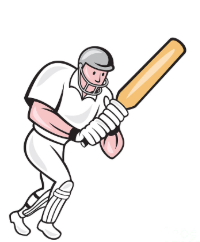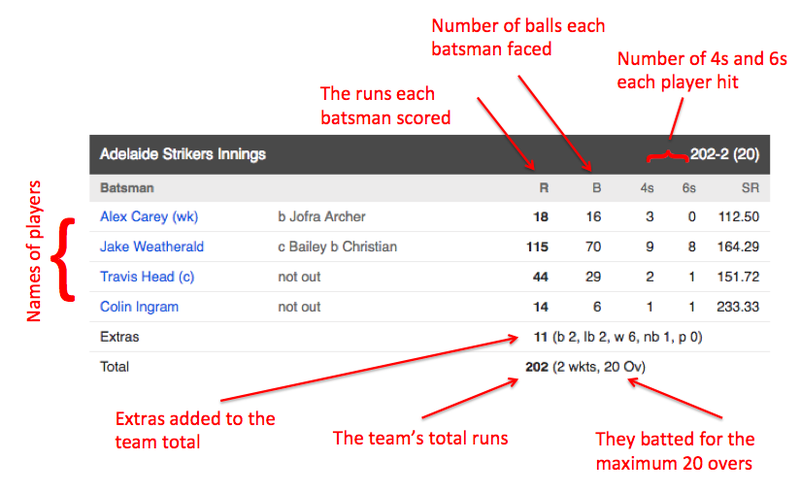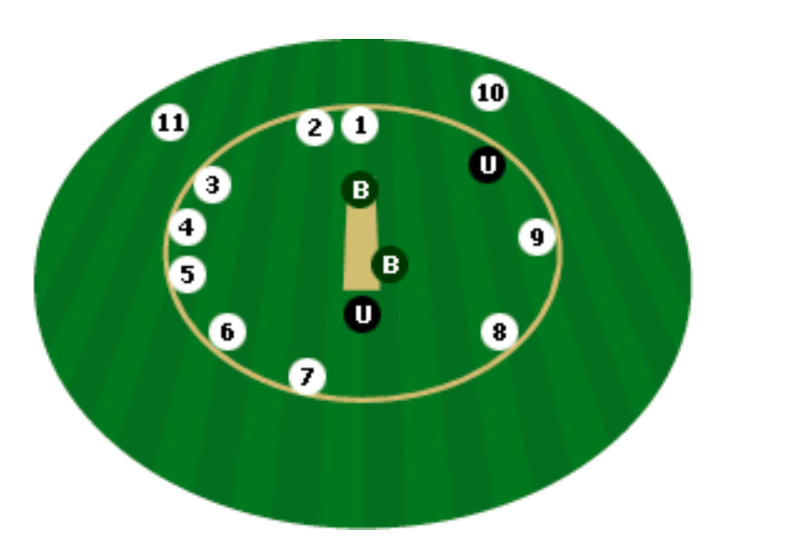I've been asked by multiple users on Scorum what I would recommend to people who have no idea about the sport of cricket but would like to give it a try and my response is always "watch T20 franchise cricket". December to May sees a huge number of those contests being played around the world and seeing as @liuke96player is also running his Hall of Fame contest on the topic of cricket, now seems the perfect time to write a beginners guide to the sport.

Perhaps one of the aspects that makes cricket so confusing to those outside the sport is the fact that it has 3 distinct formats.
There is the Test Match format which is the one that I predominantly write about. Games can take up to 5 days to complete and while the standard of Test cricket has been very high during 2018, it’s entirely understandable why someone without an existing interest in the game would struggle to get their head around such an epic sporting event.
Then there is the One-Day format which as the name suggests is a match which takes 1 day to complete. Sides are given a limited amount of time to score as many runs as they can with the side with the most runs being the winner. Simple enough but with games still taking around 7 hours to complete it's no wonder that even an ardent sports fan might be put off having to invest such a lot of time and effort to be able to get a grasp on what is going on.
Finally, we come to the newest and most accessible format of the game which is Twenty-20 or as it's often now known T20 (not to be confused with a model of terminator). These are fast, fun, action-packed games that can be completed in a couple of hours and which are already responsible for drawing new audiences towards the game of cricket. Certainly, if you are interested in dabbling a toe into cricket then T20 represents the kiddies pool, full of slides and inflatable toys compared to the seemingly endless ocean that is Test Match cricket.

T20 has fairly exploded onto the scence throughout the 21st-Century, culminating in the formation of several big-money franchise leagues across the globe. Chief amongst them is the Indian Premier League (IPL) which will begin again in April 2019 and attracts the biggest names in the sport who can now earn on a par with likes of NFL, Soccer and Basketball stars. However, the IPL is not the only franchise league out there and one of my favourite leagues, The Big Bash League (BBL) which is played in Australia is all set to begin on 19th December. I will in good time write up a full preview of the 8 teams involved in the competition whereas this post will serve as something of an FAQ on the basic rules of T20 cricket which in all honesty are pretty easy to follow once you get your head around some of the terminology used.
Another wonderful aspect of the BBL is the time of year it is played. The games are played in the evening in Australia which means that by in large they commence play at 8 am UK time and given that the initial part of the BBL coincides with the Christmas holidays, the league provides a great opportunity to just roll out of bed, load up on caffeine, switch the cricket on and pretend that it's not wet and miserable outside. Cricket Australia also does a great job of broadcasting the games to a global audience and at the very least you'll be able to find official highlights of the matches on youtube and of course via my blog.
T20 cricket - The Basics
Player Roles
Cricket is an 11 v 11 player sport with 2 basic player roles.

.
Batsman - These are the guys who are responsible for scoring points which in cricket are known as runs. Runs are scored by hitting the ball.
.

Bowler - These are the guys who are responsible for stopping the batsmen scoring runs or better yet getting them out. In essence, they throw or as we say in cricket bowl the ball at the batsman. When bowling the ball in cricket a bowler must not bend his arm hence why we don't use the term throw or pitch.
Run-scoring and how to get batsmen out is explained in further detail below.
All-rounders - While some players specialise as a batsman or bowler others are capable of doing both i.e. they are all around players. However, in cricket, you do not need to be named as a specialist batsman or bowler prior to the game starting. In fact, in some matches, all 11 players will need to bat but you can generally assume that the guys who are given the first chance to bat are the best batsmen whereas those who listed at 9, 10 and 11 are probably in the side as specialist bowlers. Similarly with bowling, in theory, any player can bowl but in reality, only 5-7 players on a team will have the skills capable of bowling at this level.
Fielders - All 11 players are required to field for their side during the game. There are many specialist positions and strange sounding names for those positions that I won't go into now, suffice to say that fielders are there to catch the ball and stop batsmen scoring runs.

There is one specialist fielding position which is crucial to understand and that is the wicket-keeper (keeper). You'll see him standing directly behind the batsman and wearing a pair of large gloves. He is the only player on the pitch allowed to use gloves to catch the ball and his role is very similar to that of a catcher in baseball.
.
What is an "over"?
Before going on to consider how to score in cricket, it's probably worth understanding the basic units with which the game is measured. The smallest unit within cricket is a ball i.e. when the bowler runs up and bowls it to the batsmen that is 1 ball. The below video demonstrates 1 ball in cricket.
6 balls = 1 over
At the end of the over the teams swap ends and a different bowler has to bowl i.e a player can't bowl consecutive overs. In fact, in T20 cricket a bowler is only allowed to bowl a maximum of 4 overs and that is because T20 cricket is what is known as limited overs cricket with each side having a maximum of 20 overs (120 balls) to score as many runs as possible. The short nature of the game is what keeps the pace of the matches high because batsmen are required to take more risks and hit the ball higher and longer than in any other form of cricket.
Above is an over (6 balls) in which Pakistan failed to score a single run! It's pretty rare for this to happen in T20 cricket with teams usually aiming to score 8-10runs an over throughout their innings meaning an average score will be 160-200 runs.
Scoring runs in cricket
There are always 2 batsmen batting in cricket at any one time. 1 batsman is facing the bowler who bowls the ball to him while the other waits at the other end. If the batsman facing the ball hits it with his bat then he can score runs.
The easiest way to score runs is for the 2 batsmen to change ends. As you can see from the slightly fuzzy clip below, the batsman hits the ball and the 2 players keep running until the ball is thrown back by one of the fielders - you'll actually notice in this clip that the batsmen should only have gotten 3 runs but because of a mistake known as a misfield they managed to keep running. It's rare in cricket for batsmen to score more than 3 runs by running back and forth like this simply because they must make sure they are back in position before the ball is thrown back in or they risk being run-out (see below).
The other, faster way to score runs is to hit the ball beyond the edge of the playing area. If the ball hits the ground on the way to also hitting the boundary (the edge of the playing area) then the batsman is given 4 runs as shown in the example below
Alternatively, if a batsman can hit the ball over the boundary on the full then he is awarded 6 runs. The below video shows the biggest 6s from last years BBL, as you can see these boys can hit the ball a loooooong way - you don't get extra runs for hitting it out of the stadium ;-)
Unlike other bat and ball sports, in cricket, a batsman can keep scoring runs until either he is out (see below) or the 20 overs are finished. That means that when a top batsman gets going and starts to hit big then he tends to keep going! It's also worth noting that in cricket, players can score 360 degrees around the pitch, it means that there are a huge variety of different shots that can be played which again all have strange and foreign-sounding names.

The other way to score runs in cricket is via extras. These usually occur when the bowler does something wrong. For example, a no-ball which is where a bowler does not keep his foot behind the line that all bowlers must bowl from or a wide where the umpire judges that the ball was bowled too wide for a batsman to have a chance of hitting it. On both occasions, a bonus run will be added to the team score and the bowler will have to bowl the ball again i.e. it doesn't count towards the 6 balls needed to complete an over. Equally, if the ball hits the batsman but doesn't hit his bat then they can score leg-byes or indeed if it misses everything all together they can try and sneak a run which is known a bye. Again on each occasion, the run is added to the team's overall score.
How do you get batsmen out in cricket?
There are 4 primary methods for getting a batsman out in cricket
Bowled
This is where the bowler manages to hit the stumps (the 3 pieces of wood). That is pretty much it - hit the target and that's the end of the batsman's innings, let's see it in action
Caught
Again pretty self-explanatory, a batsman hits the ball in the air and if a fielder can catch it before it hits the ground then they are out caught
Run Out
As mentioned above, batsmen can score runs by running from one end to other. However, they must ensure that they have reached the end before the fielding team collects the ball and hits the stumps. If they are short of their ground then a batsman is run out.
Leg-Before-Wicket (LBW)
This is where things get a little more complex but in essence, if a batsman prevents the ball from hitting the stumps with anything but his bat or his hand that is holding the bat then he can be out LBW. Of course, the basic dimensions of both a man and the stumps mean that it is usually his leg or perhaps his foot that gets in the way of the ball hitting the stumps. There are several other sub-rules that govern LBWs but given that this is a beginners guide we will probably leave those for another day
There are several other ways that batsmen can be given out but some of them are so rare that you could spend your entire life watching cricket and never actually see such an incident occur.
It's worth noting that in cricket there is no such thing as a double-play i.e. if one batsman is out caught you can't then run-out the other one.
In T-20 cricket you only get one chance so once you are out then you are out. The ultimate aim for the bowling side is to get 10 of the opposition batsmen out. If they achieve this then the innings is finished regardless of how many of the 20 overs are left to be played.
Simple Tactics
You could read several books on the tactics of cricket and still not know half the picture, however, because T-20 is such a short game the ultimate aim of batsmen is to whack the ball as hard and as often as possible and the ultimate aim of the bowlers and fielders is to stop them doing it.
There are however a couple of tactical situations it's worth being aware of
Field Restrictions - When watching a T-20 game it's tempting to wonder why all the fielders aren't just back on the edge of the pitch trying to stop batsmen hitting 4s and 6s. Well the reason for that is they aren't allowed to! You'll notice on a T-20 cricket pitch that there is an inner circle as seen in the picture below. During the first 6 overs of each innings, only 2 fielders are allowed to be placed outside that circle. After 6 overs a maximum of 4 fielders can be placed outside the circle. Having just 2 fielders back on the edge of the pitch is designed to tempt batsmen to take more risks and hit the ball up and over the fielders close in, as such those first 6 overs are known as The Powerplay and they often involve big hitting and high scoring

Winning the toss - At the start of any cricket match, the 2 captains toss a coin with the captain who chooses correctly getting the option of whether to bat or bowl first. Traditionally sides have preferred to bowl first simply because when it then comes their turn to bat they know exactly how many runs they need to score and the risks they need to take in chasing the opposition's total. From a spectators point of view what you hope is that the game delivers a close finish where a team potentially wins from the final ball as was the case below in last year's BBL
That's it! You could easily understand and enjoy a T20 cricket match having read the above. In terms of TV viewing figures, cricket is the 3rd most popular sport on the planet. See what all the fuss is and start watching the BBL which starts on 19th December.
As well as the blog, I may decide to run a fantasy league on the BBL. As always it will all be time dependant.
Comments